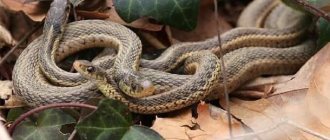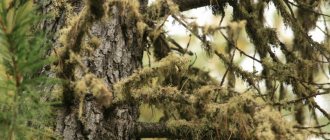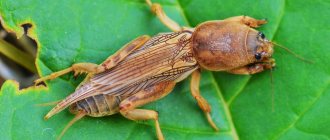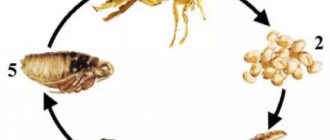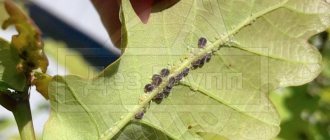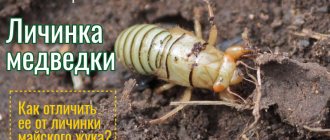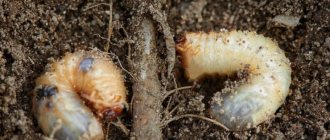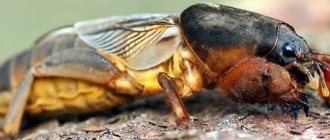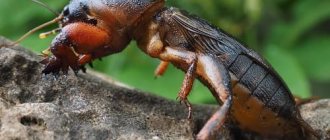Home » Useful information
Olga Polyakova 05/19/2020
44234 Views 1 comment
A pest like the mole cricket is unique in its own way. Firstly, this is a creature capable of moving in all available ways: from underground to air; and even in entering this pest is very dexterous and fast.
Secondly, an insect can eat almost any food of plant origin; Although giving preference to tuberous crops, the mole cricket, in their absence, perfectly adapts to the diet that its habitat provides it with.
No plant is immune from this pest. And finally, thirdly, it has excellent adaptability and high survivability. In addition, the insect is very cautious and timid.
Medvedka. Description and photo
The mole cricket insect has clawed front legs, it is large, brownish-brown, so it is compared to a brown bear. Hence the name. Among the people , the beetle that loves to eat young cabbage seedlings has received a second name - “cabbage weed” .
Photo taken by: michel-candel Gryllotalpa – Orthoptera (license)
Photo taken by MirandaKate mole cricket (license)
There is also an official Latin name - Gryllotalpa, which means “mole cricket”. The cricket and the cabbage grass have a similar body structure and have the ability to make sounds . The similarity with a mole lies in the ability to move underground using the extended hands of the front legs.
The common mole cricket has a terrifying appearance. The length of her body, including the tail and mustache , is 12 cm.
Detailed description, photo and characteristics of the bear:
- cylindrical body shape
- body length 5-7 cm, head and abdomen are protected by a shell
- paired tentacles and long whiskers on the head
- two pairs of wings (the first are short and oval, the second are narrow and long), folded on the back, with the help of such wings the cabbage bird can fly up to a height of 5 m from the ground
- bulging, small eyes
- spatulate and massive front paws with claws, with the help of which the insect easily burrows into the ground
- the second paired limbs are long and thin, designed for rapid movement along the soil surface
- long hind legs allow the insect to jump
An example of adaptation and versatility. Runs fast, jumps, flies, swims and digs holes. Eats plants and animals. The head and abdomen are protected by a shell. That's why they are one of the most ancient types of insects.
You can see what a mole cricket and its larvae look like in the photo.
Fighting a mole cricket in a garden plot is not an easy task. Some of the larvae and adults are eaten by birds , insectivorous animals that also live underground. But gardeners still have to take measures to eliminate cabbage weed in order to save crops from death .
Often, summer residents themselves contribute to the appearance of a pest in the garden when they import manure to fertilize the soil in which cabbage mushrooms and their larvae live.
Nest Features
Mole cricket burrows in the garden are a unique structure with numerous passages and exits. The main part looks like a rectangle. There the insect rests, hides from enemies, and breeds offspring. On the surface, the exit or entrance looks like a large or small hole. You can catch a mole cricket in various ways.
The mole cricket's passages on the ground extend from the nest in different directions. They have a spiral shape, the hole goes to the surface. In this way, the female ensures free air circulation and heat supply. To prevent the area from being shaded by plants, the female gnaws the stems, after which the crops dry out. Eggs are laid at the time when seedlings are planted in the beds, which is why many gardeners have to save them.
Mole cricket habitat
On a note!
Numerous labyrinths are located underground at a depth of 5–70 cm. It all depends on soil moisture. If there is a lack of moisture, the larvae either do not hatch or die immediately after hatching.
What does mole cricket eat?
The mole cricket's diet is extensive: the root system, tubers, seeds, underground parts of the plant, young shoots. The pest likes fruit, vegetable, berry, garden, and melon crops:
- beet
- potato
- cabbage
- cucumbers
- pepper
- tomatoes
- melons
- watermelons
- sunflower
- strawberry
- parsley
- beans
- wheat
- oats
- corn
- millet
- various shrubs
One adult can destroy up to 15 plants per night.
In warm regions, the insect feeds on citrus fruits, cotton, tea, and peanuts. In gardens, trees that suffer from cabbage weed include cherry, pear, apple, peach, and apricot. In forests, the beetle's diet includes the roots of young trees: oak, pine, spruce, and beech.
An adult is a predator that eats worms, ladybugs, larvae of May and Colorado beetles. Plants often die because cabbage grass moves underground in search of animal food and damages the root system on its way.
larva feeds on small roots, seeds, worms, and small insect larvae, as it leads a sedentary lifestyle and has poorly developed jaws.
What crops are affected by the pest?
The pest is a polyphage - an omnivorous insect . Threatens grain, fodder, vegetable plants, berries and ornamental crops . In spring, it is dangerous for young shoots, seedlings, and seedlings of herbaceous plants. The mole cricket destroys sown grains and sprouted seeds. The roots of mature trees and shrubs are too tough for her.
Among vegetables, it often damages tomatoes, eggplants, peppers, cucumbers, carrots, beets, corn, peas, potatoes, cabbage, zucchini, onions, and lettuce . Among berry crops he loves strawberries and grapes . It can eat ripe strawberries , gnaw ripe pears, apples, and plums . The pest finds this prey by crawling out of its burrows at night. The mole cricket is not a vegetarian; it can eat earthworms, other soil inhabitants and insects, including harmful ones.
Where does the bear live?
Cabbage grass lives almost throughout the entire European territory, with the exception of the Netherlands, Finland, and Norway. Residents of the Caucasus, Southeast and Central Asia, India, China, the Japanese and Philippine Islands, Australia, South and North America, and the Northern regions of Africa have to fight the pest. In Russia, the insect is found almost everywhere, with the exception of the northern regions.
The beetle lives in damp places, meadows, near ponds, and lives in tunnels underground. The insect likes fertilized, warm, humus soil, so it is often found in summer cottages, wetlands and near irrigation canals.
Behavior
The mole cricket spends most of its life underground. There it digs passages, builds labyrinths, and builds nests. It comes to the surface at dusk in warm weather. Looks for food or rises into the air to search for a male.
The body structure of the mole cricket allows it to swim on the surface of the water. She calmly overcomes a large puddle and escapes the flood. But if water gets into the burrow, the insect dies.
The heat-loving insect successfully survives winter frosts through half the soil. With the onset of heat it gradually rises to the surface. The presence of the pest in garden plots can be noticed as early as April. Paths form in the ground, footprints are visible, and plants die.
On a note!
The mole cricket is a timid creature that hides in a hole at the slightest rustle. It is impossible to catch her with your own hands. But, if you build a trap, you can significantly reduce the number of insects on the site.
Lifestyle of the mole cricket
Kapustyanka is an ancient species of insects that appeared on our planet among the first millions of years ago, so it is difficult to fight this pest. It is resilient and easily adapts to changes in the environmental conditions in which it lives.
Photos of the garden pest demonstrate that the mole cricket genus is orthoptera. With the help of its wings , the beetle moves long distances in search of food. A large number of legs that perform different functions allows it to swim .
Mole cricket wings
To understand how to get rid of a mole cricket, you need to know what kind of life this insect leads. During the daytime, it hides in underground passages and hunts mainly at night . You can see where the cabbage grass has crawled by the winding loosening of the soil and small holes in the ground. If a healthy plant grew nearby and began to die , then it was most likely spoiled by an insect pest.
Mole crickets lay their eggs in nests near plants. To ensure that the nest is well ventilated, the female constantly cleans the underground tunnels. She gnaws the roots of plants that cast a shadow on the nest, so the plant crops die. The mole cricket larva can also cause a lot of harm to gardeners. It gnaws small roots, after which the crop begins to hurt and wither.
The fight against cabbage weed must begin in the fall . All crops should be removed from the land, even fruits and roots that are not suitable for food. With the arrival of spring, the remaining fruits are good food for the insect.
Prevention measures
The mole cricket is a very tenacious insect, easily adapting to various conditions and capable of moving long distances. Therefore, if it becomes known that neighboring areas have been attacked, it is necessary to urgently take measures to prevent soil contamination.
For prevention, you need to use the following methods:
- in spring and autumn, dig up the soil on the site;
- try to avoid using manure as a fertilizer, since it is in it that mole crickets often enter the area; it is safer to replace it with chicken droppings;
- in the rows and along the entire perimeter of the garden, plant plants with a mole cricket-repellent aroma - coriander, marigolds or chrysanthemums;
- to reduce soil temperature, use mulching with light-colored materials - straw or sand;
- monitor the level of soil moisture and not allow it to exceed it; it is especially important to observe this point in greenhouses.
Mole cricket reproduction
In the spring, when the soil warms up well, pests crawl out of their holes en masse. The mating season begins in May. Insects mate underground, and in the summer they already have offspring.
Kapusyankas are responsible and caring parents who carefully prepare for the appearance of their offspring. They dig underground passages in a special way to provide air access from different sides. A spherical nest, the diameter of which is 10 cm, is formed at a depth of about 5 cm. One such nest can contain up to 500-600 eggs; in appearance they resemble millet grains - oval, yellow-gray, about 2 mm long.
The female is constantly at the nest, providing the necessary temperature and ventilation. After about 15 days, the eggs hatch into larvae that look similar to the offspring of the cockchafer.
Mole cricket larva
Description of the larva:
- small gray creature
- body size 3 cm, covered with a dense shell
- has 6 legs
- without wings
The female for about a month , after which she dies . The strengthened larvae begin an independent life, dig holes and look for food. To acquire the appearance of a full-fledged adult, the mole cricket larva goes through a long period of development, including 4 stages:
- egg
- larva
- nymph
- imago
Full development takes up to 2 years. molts 10 times ; the formation of the genital organs occurs at the last stage of the individual’s maturation.
Mole cricket eggs
Mole cricket nymphs
Mole cricket in late nymph stage
Mole cricket in the imago stage (adult)
Repellent methods
Folk method of struggle
The mole cricket, like all insects, is able to distinguish odors well. There are odors that are both pleasant and unpleasant for insects. The list of the latter is quite extensive - it includes both the smells of certain substances and the smells of certain plants.
Therefore, to avoid the appearance of an uninvited insect, it is recommended to use the following methods:
1 In the spaces between the rows, as well as along the perimeter of the site, you can plant plants that are “unpleasant”
- calendula
- marigold
- chrysanthemums
2 To protect potato crops from insects, after flowering, you need to place branches of coniferous plants between the rows:
- fir
- ate
- pine trees
Mulching with pine needles between rows
3 Make stakes up to 40 cm long from freshly cut aspen or alder branches (at least 30 mm thick). They must be buried at a distance of at least 25 cm at a distance of no more than 1.5 m from each other. In this case, the bark should remain on the stakes. The stakes should be renewed as they dry out.
4 It is recommended to fill the mole cricket’s passages with a solution of onion peels
5 When planting plants, it is recommended to add a peeled clove of garlic under each plant.
6 Instead of garlic, you can put small fish (not salted, of course) under each plant.
7 Greenhouses should be fenced around the perimeter with furrows 5-10 cm deep, into which pour naphthalene or sand moistened with kerosene
8 For root plants (beets, carrots, parsley, etc.), it is recommended that the first watering be done with a solution of iodine in water (10 drops of iodine are dissolved in 5 liters of water)
Natural enemies of mole crickets
The beetle is to the taste of many animals, is susceptible to fungal diseases, and acts as an intermediate link in the reproduction cycle of other insect species.
Moles feed on cabbage grass ; birds, lizards, rodents, toads, and spiders prey on it.
Burrowing wasp and mole cricket
Wasps lay eggs in the insect's body. The body of the cabbage plant serves as food for the hatched larvae.
How to deal with a mole cricket
Summer residents are constantly looking for an answer to the question of how to get rid of mole crickets in the garden forever. To achieve this, there are many preventive measures and methods of pest control: the use of all kinds of chemical and biological preparations, traps, repellers, and folk remedies. It is better to start the fight with folk remedies that do not harm the soil and plants and do not lead to the death of worms. If the effect of the methods used is small, then you can move on to more radical measures and use chemicals.
When deciding how to deal with mole crickets, you need to understand that an insect that managed to survive mammoths will not be easy to destroy. An integrated approach is needed, which includes several methods of struggle.
The most effective fight against mole crickets is in the spring, when the larvae and adults have not yet fully awakened and there are no cultivated plants on the land plot.
By May, the number of adults in gardens increases. During this period, the beetles leave their wintering places, crawl to the surface and mate. It is important have time to fight the insect before the eggs are laid. In May, there is still little vegetation in the gardens, so the cabbage grass willingly crawls into traps and baits and eats the poison.
Traps
Adherents of ecological farming should figure out how to deal with mole crickets in the garden using traps. Local places with favorable conditions for insect habitat and reproduction are created on the site. Traps are effective in spring and fall.
To form a trap, make a hole , the width and depth of which should not exceed 50 cm. Polyethylene , and a mixture of straw and manure is sprinkled on top. In the spring, cabbage ducks look for such places for nesting, and in the fall - for wintering.
After about 30 days the trap is checked. If adults, eggs or larvae appear in it, then the polyethylene should be removed along with the contents and burned . frosts occur , manure along with nests must be scattered over the land. During this period, insects are no longer active and will not be able to hide underground, so they die from sub-zero temperatures.
Mole cricket trap
Folk remedies
The fight against mole crickets is based on the behavioral characteristics and food preferences of the pest.
- Proper soil cultivation. The soil must be dug up twice a year: in autumn and spring. During digging, the underground tunnels and burrows of the cabbage plant are destroyed and the larvae are destroyed.
- Baits with a poisonous substance. The method is suitable for early spring, when the first plants have not yet sprouted in the garden. To construct the bait, steam wheat, corn or barley and sprinkle it generously with Aldrin (an odorless powdered pesticide). For 1 kg of grain you will need about 50 g of the substance. The prepared grain is placed in different places on the land. After some time, you need to walk through the area and collect dead pests.
- Using vegetable oil and soapy water. For this method it is necessary to discover the entrances to underground tunnels. Pour soapy water in large quantities or drop a few drops of oil. The soap solution is prepared in arbitrary proportions using laundry soap or washing powder.
- Shadow traps. The effectiveness of the method is based on behavioral factors. On warm spring days, the insect crawls to the surface to bask in the sun. To destroy the pest, shadow traps are organized. Take dense dark material, which quickly heats up under the sun's rays, and lay it out over the area. Bait with poison is placed under pieces of such material After a few days, all that remains is to walk through the garden to collect the “harvest.”
- Water and beer traps. Cabbage grass is attracted by the smell of beer and honey, so jars are buried , the neck of which is placed at the level of the soil surface.
The jar is filled 1/3 with beer. A board is placed on the neck, leaving a gap of 1.5 cm. Beer can be replaced with water. But in this case, the neck of the container is lubricated with honey. Beer trap for mole cricket - Formation of mechanical barriers. Seedlings and young plants can be protected with plastic. plastic bottles are dug around the bed . When planting seedlings, you can put a nylon stocking on each plant. In this case, large roots will be protected from the pest, and damage to small roots that will penetrate through the holes in the nylon will not affect the health of the plant.
- Application of chicken manure . The droppings must be diluted with water, water the plants with the resulting solution and pour it into the beetle holes. Chicken manure contains many beneficial substances for soil and plants. Nitrogen, which is part of the droppings, is a means of combating the pest, as it makes it difficult to breathe underground. The insect will not die from it, but will immediately leave the land plot. To breed cabbage weed, you need to use only chicken manure. Applying cow dung will increase the number of beetles in your garden.
- Summer residents often use the proven Michurin method of getting rid of cabbage weeds. It will require sand to which a few drops of kerosene . Such sand must be spread out into the holes in small quantities.
- The insect does not like the smell that rotting fish gives off. At the beginning of the summer season, fish heads are buried along the edges of the beds. The “treasure” gradually begins to decompose and expels the pest from the area with its smell.
If within 2 years of use folk remedies do not lead to the desired result, it is necessary to use chemicals.
Chemicals
The fight against mole crickets in the garden using chemicals involves the use of imported and domestic preparations. They are available in powder or granule form and are always effective in controlling insects.
Preparations that have proven themselves well among gardeners:
- Medvetox - the drug is intended for the destruction of cabbage grass and garden ants, does not harm the soil and earthworms
- Rembek - the drug has a long-lasting effect, fights cabbage grass, chafer beetles, and garden ants
- Medvetsid - granules that lead to the death of the insect within 3 hours after eating
Calcium carbide , which gardeners place in small quantities in the pest's holes, 5 g in each hole, will also help get rid of mole crickets During the reaction with water, acetylene gas is released, which fills all underground passages and leads to the death of the insect.
Ultrasonic repellers
If you are interested in the question of how to get rid of mole crickets without using chemicals and traps, then you can use ultrasonic repellers. This expensive but effective remedy will help get rid of not only cabbage weeds. Snakes, moles, and shrews, which are unwanted guests in summer cottages, respond to ultrasound.
The device is safe for humans, plants and pets. The sound produced by the device has a special frequency that is unbearable for pests, and they will try to move away from the device.
Biological agents
Experienced summer residents know how to deal with cabbage grass without destroying beneficial insects - with biological products. For these purposes, the powder preparation Boverin is used. It is the causative agent of a fungal disease that can infect the body of an insect. The drug contains fungal spores. When they enter the body of a pest, they begin to grow and lead to its death. The composition of Boverin is safe for humans, animals, birds and other insects.
Another popular biological product is Nemabact. It contains bacteria and predatory nematodes. The nematode is able to penetrate the body of the larva and infect it with bacteria. As a result, decomposes . Nemabact provides good results in pest control, but it must be used and stored correctly.
The drug can only be used at an air temperature of no more than +25ºC, distributing it over the beds. You can use the refrigerator for storage.
Mole cricket (cabbage moth) is a pest that can destroy almost the entire crop in the garden; peaceful coexistence with this beetle is impossible. The insect is resilient, so to remove it from a summer cottage it is necessary to use a set of control methods. In addition, preventive measures should be carried out, such as mandatory digging of the soil to a depth of 15 cm in autumn and spring.
Chemical control
The chemical industry produces many insecticidal preparations that successfully combat
bear:
- "Medvetox";
- "Medvecid";
- "Boverin";
- "Rembek";
- "Phenaxin Plus"
As a rule, it is enough to add the recommended amount to the soil during autumn and spring digging, or directly into the holes. Experienced gardeners, when adding this “delicacy” to the bear, flavor it with vegetable oil so that the smell attracts insects.
The dosage and method of use of the drugs are always described on the manufacturer’s packaging. It is imperative to comply with these requirements, since if you save on money, you can skip the spring wrestling season. As a result, the mole cricket will get another year, during which it will breed huge offspring.
Despite its terrible appearance and ability to quickly multiply and spread, the systematic and methodical destruction and scaring away of this monster insect will clear the area of it and get an excellent harvest.
If you read this article to the end, you may have found it helpful. Share the information with your friends and like-minded people, and they will thank you. Join our groups on social networks, write comments, help make the project even more interesting!

